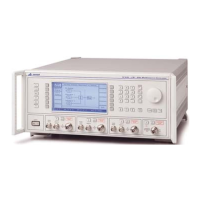46882/439 1-1
Chapter 1
GENERAL INFORMATION
Contents
Introduction....................................................................................................................................1-1
Main features .................................................................................................................................1-2
Operation
................................................................................................................................1-2
Display
....................................................................................................................................1-2
Frequency selection
................................................................................................................1-2
Output
.....................................................................................................................................1-2
M
odulation..............................................................................................................................1-2
Increm
enting...........................................................................................................................1-3
Frequency sweep
....................................................................................................................1-3
Mem
ory...................................................................................................................................1-3
Program
ming ..........................................................................................................................1-3
Calibration data
.......................................................................................................................1-3
Spectral purity
.........................................................................................................................1-3
Calibration
..............................................................................................................................1-3
Perform
ance data ...........................................................................................................................1-4
Versions, options and accessories
..................................................................................................1-9
Introduction
The 2026 is a multisource signal generator offering as standard two signal sources in one
instrument. Up to three sources may be fitted, each of which is a fully functional modulated signal
generator. Each source can either be routed to its own individual RF output or switched to the
input of an RF combiner network before being fed to a separate combined RF output. All sources
cover the frequency range 10 kHz to 2.4 GHz. An additional RF input is provided to enable the
output from an external RF signal generator to be combined with the signals from up to two
internal sources.
Each signal source can be controlled independently in frequency and level, and each has its own
amplitude, frequency, phase, FSK and pulse modulation capability. All parameters can be entered
from the front-panel keyboard and a rotary control can be used to adjust most settings. The
instrument includes a GPIB interface which allows remote control of all standard signal generator
functions except the supply switch.
The instrument is provided with built-in tests specifically for use with two or three combined
sources such as for amplifier and receiver intermodulation tests and receiver selectivity tests.
The sources may be locked together, offset in frequency (additionally with a harmonic or
sub-harmonic relationship) as well as level.
Microprocessor control ensures that the instrument is flexible and easy to use and allows
programming by the General Purpose Interface Bus (GPIB) or RS-232 serial bus. The GPIB is
designed to IEEE Standard 488.2 and is a means of sending commands to an instrument, via a data
bus, from a remote controller or personal computer. The instrument can therefore be used
manually or as part of a fully automated test system.

